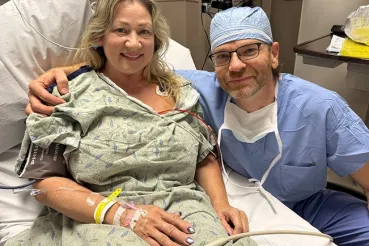Body fat now can help treat bone joint conditions, including injuries and osteoarthritis — the type of arthritis caused by wear and tear in tissue between joints, which affects 27 million people. A new device gently suctions, processes and uses a patient’s own fat tissue to provide a potential source of stem cells and growth factors to promote healing.
Orthopedic physicians at Rush University Medical Center are the first sports medicine specialists in the Midwest to offer treatment with the device, called Lipogems, used at the time of arthroscopic surgery. The FDA approved Lipogems for widespread use in November of 2016.
“The technology is ideal for patients with certain orthopedic conditions, such as painful joints — including the knee, ankle or shoulder — with limited range of motion. Additionally, it can be used in soft tissue defects located in tendons, ligaments and/or muscles to improve the biologic environment,” said Dr. Brian Cole, professor of orthopedic surgery and section head of the Rush Cartilage Restoration Center at Rush University Medical Center.
“Fat has long been used for support of tissue repair and replacement,” Cole said. “Fat has the ability to be a source of important cells which produce important proteins involved with healing and reduction in inflammation.” The Lipogems system liposuctions fat cells from the abdomen or thigh while the patient is sedated with a local anesthetic.
The Lipogem procedure rinses and cleans inflammatory oils and blood from the harvested fat and keeps the natural and beneficial properties of the fat tissue, which is injected into the injured site. The entire procedure from harvesting to the injection is completed in less than 30 minutes.
The fat tissue tends to remain in the area where it is injected instead of being immediately reabsorbed by the body, allowing the body to maximize the benefits of the injection for an extended period of time. Following injection, the tissue promotes healing and symptom reduction as early as three weeks after treatment.
Lipogems treatment is at times used when standard treatment options such as physical therapy, nonsteroidal anti-inflammatory drugs, or steroid injections have not provided significant relief. “It offers benefits for people who are unable to get surgery, would like an alternative to surgery, or it can be used in conjunction with their surgery,” Cole said.
In April, Cole became the first doctor in Chicago to use Lipogems in tandem with arthroscopic surgery, which he performed on a patient with knee arthritis. Cole says “while we were thoughtful about the timing of utilizing this technology to be sure there were no significant safety issues, we are anxious to now examine the efficacy of this novel treatment.”
Cole is also interested in implementing and studying the Lipogem procedure as an adjunct to other soft-tissue problems such as rotator cuff tears and tendon or ligament injury.
“We are excited to be offering this alternative to our patients and are conducting ongoing basic science and clinical research trials on patients with knee arthritis and other conditions to investigate the role of stem cells and growth factors that are present in the small blood vessels in fat.”




